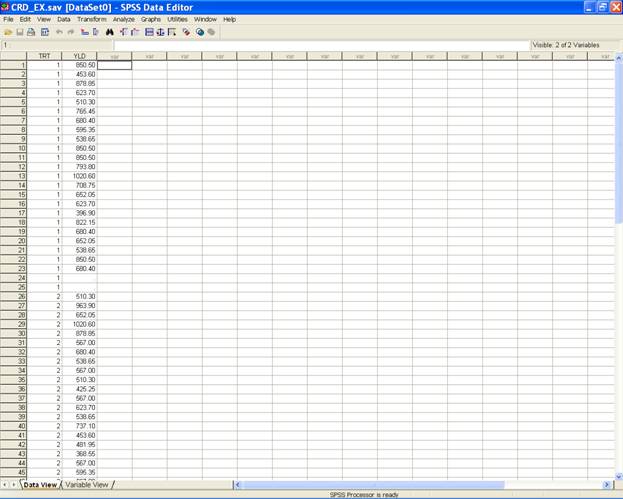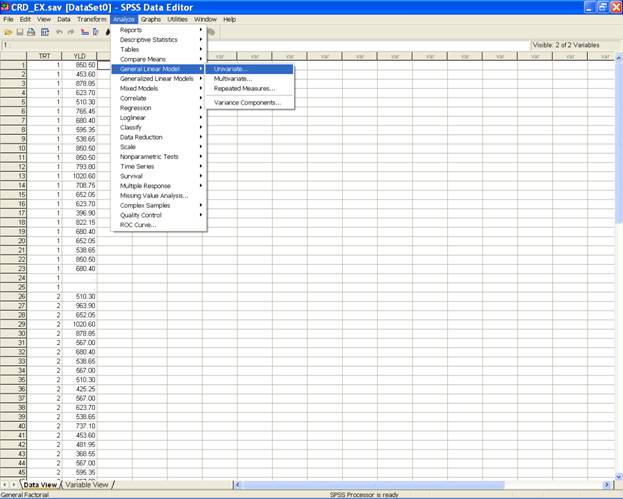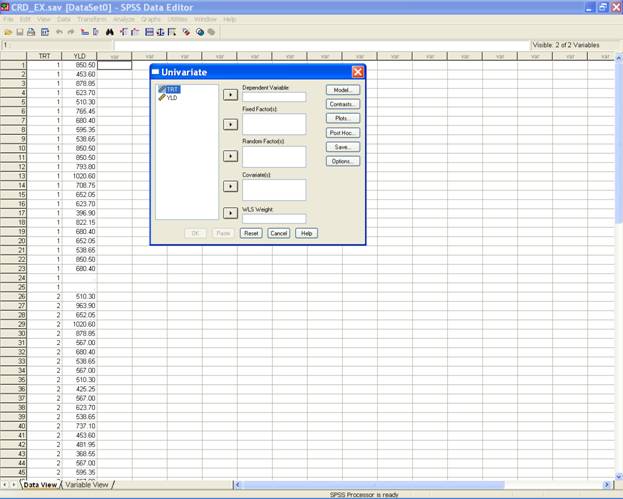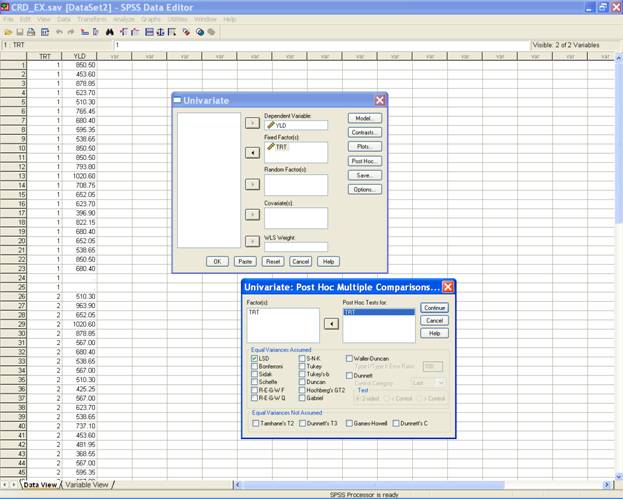 |
Analysis of Data from Designed Experiments |
 |
|
Completely Randomised Design |
<<Back
Analysis Using SPSS
For
performing analysis, input the data in the following format.
{Here
we call the feeds as treatments: TRT and yield as YLD. It may,
however, be noted that one can retain the same name or can code in any
other fashion}.
For
ease of understanding, recode the three feeds from 1 to 3 as follows:
|
FEEDS |
TREATMENT
NO. |
|
Pasture
(control) |
1 |
|
Pasture
and Concentrates |
2 |
|
Pasture,
Concentrates and Minerals |
3 |
Following are the
brief description of the steps along with screen shots.
· Open Data editor: Start®
All Programs ® SPSS for Windows®
SPSS 15.0/ SPSS13.0/
SPSS10.0

· Enter data in SPSS Data editor. There are two views in SPSS Data Editor. In variable view, one can define the name of variables and variable types string or numeric and data view gives the spreadsheet in which data pertaining to variables may be entered in respective columns.

· Once
the data entry is complete, Choose Analyze from the Menu Bar. Now
select
Analyze® General
linear Model ®
Univariate.

· This selection displays the following screen

· Select YLD and send it to the Dependent
Variable box; TRT may be selected for Fixed Factor(s) box. After doing
these the dialog box should be like this.

·
Now define model as per design adopted to analyze the data. A Click on
the model displays Univariate: Model dialog box. Click on custom
then change the Build Terms as Main effects and send
TRT(F) to the Model box.
One
gets the following screen

· Click Continue to return back to the
Univariate dialog box,
· Now select any one of the postHoc option to
select the desired multiple pairwise comparison procedure from
the following screen:

· Click Continue to return back to the
Univariate dialog box,
·
Click on OK to get the output.
To
answer the questions 1 and 2 one can define the following syntax in the
syntax editor after creating the data file.
UNIANOVA
YLD
BY TRT
/METHOD =
SSTYPE(3)
/INTERCEPT =
INCLUDE
/POSTHOC = TRT
( LSD )
/CRITERIA =
ALPHA(.05)
/DESIGN = TRT .
Analysis Using SAS Analysis Using SPSS
Home Descriptive Statistics Tests of Significance Correlation and Regression Completely Randomised Design RCB Design
Incomplete Block Design Resolvable Block Design Augmented Design Latin Square Design Factorial RCB Design
Partially Confounded Design Factorial Experiment with Extra Treatments Split Plot Design Strip Plot Design
Response Surface Design Cross Over Design Analysis of Covariance Diagnostics and Remedial Measures
Principal Component Analysis Cluster Analysis Groups of Experiments Non-Linear Models
Copyright Disclaimer How to Quote this page Report Error Comments/suggestions
(Under Development)
For
exposure on SAS, SPSS,
MINITAB, SYSTAT and
MS-EXCEL
for analysis of data from designed experiments:
Please see Module I of Electronic Book II: Advances in Data Analytical Techniques
available at Design Resource Server (www.iasri.res.in/design)